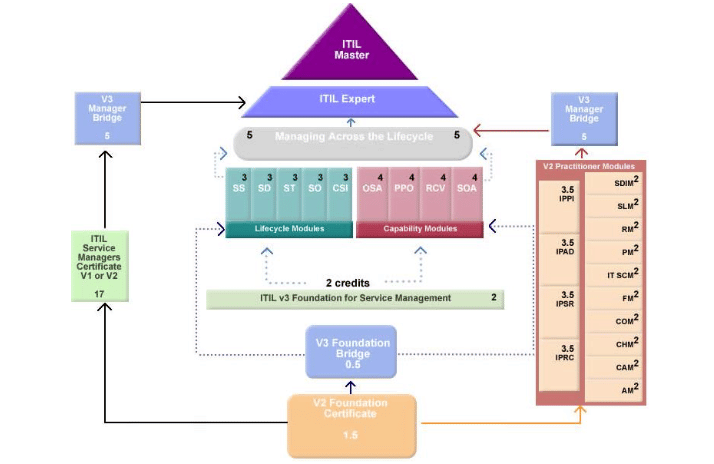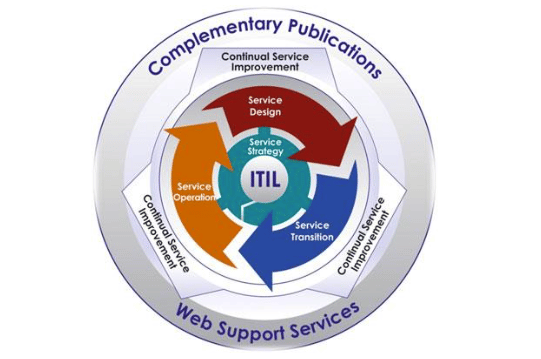ITIL (Information Technology Infrastructure Library or Library of Information Technology Infrastructure) is a compendium of publications, or bookstore, that systematically describe a set of “good practices” for the management of Information Technology services (hereinafter IT ).
Organizations are increasingly depending on IT tools to carry out their daily work. This work is also managed and controlled through other computer systems, these being in turn within a network controlled by other systems and so on. Therefore, the complexity of these processes increased the demand and need of entities (public or private) to have a model that allowed them to manage their IT infrastructure more easily and that could support business objectives.
ITIL was born in the 1980s, through the British Government’s Central Computer and Telecommunications Agency (CCTA), which devised and developed a guide to make British public sector offices more efficient in their work and therefore the costs derived from IT resources will be reduced. However, this guide proved to be useful for any organization, being able to adapt according to its circumstances and needs. In fact, it turned out to be so useful that currently ITIL includes the management of IT services as one of its sections, having expanded the set of “good practices” to information security management, service level management, business perspective, software asset management and application management. These good practices come from the best possible solutions that various experts have implemented in their organizations when delivering IT services, so that sometimes the model may lack coherence.
Currently ITIL belongs to the British Office of Government Commerce (OGC), but can be freely used for its application.
Contents
The bookstore
ITIL did not begin to be used in common way until approximately 1990; Since then, the growth of the bookstore stood at approximately 30 publications that made its use a complex process. Therefore, a revision was required that grouped the books according to structured sets in the processes that were most closely related, framing the large number of publications existing in eight volumes, since then known as ITIL v2.
The last version was released in 2007, called ITIL v3. In this version a refreshment has been carried out (refreshment in the words of the OGC), grouping the main elements of ITIL in 5 volumes, which can be found at present with the following titles (in original English)
ITIL v3 Service Strategy (SS)
ITIL v3 Service Design (SD)
ITIL v3 Service Operation (SO)
ITIL v3 Continual Service Improvement (CST)
ITIL v3 Service Transition (ST)
These 5 books make up “the ITIL life cycle” (ITIL Lifecycle)
In addition and as a support, extra, complementary information and related to other aspects related to IT, you can find a multitude of publications that make up the entire workflow of IT-related processes through ITIL.
ITIL working flow / Relationship to publications. Source: OGC
In a brief way we will describe what these volumes of ITIL v3 contain and what they refer to, in order to begin to introduce the student to what will be the future basis on which the manual will be developed.
1. Service Strategy – Service Strategy (SE)
Designs the action plan that will allow developing a strategy in the Organization regarding the Technologies of the
Information.
It develops several areas; These include the following: General strategy, competitiveness and market positioning, types of service providers, service management as a strategic factor, organizational and strategic design, key processes and activities, financial management, service dossier, management of the demand, and key responsibilities and responsibilities in the service strategy.
2. Service Design – Service Design (SD)
This volume develops the concepts related to the design of IT Services, such as the design of architectures, processes, policies, documentation. It also delves into Service Level Management, design for capacity management, continuity in IT services, supplier management, and key responsibilities in service design.
3. Service Operation – Service Operations (SO)
In the book of operations, the best practices to be put in place to get to offer a level of service of the Organization according to the requirements and needs of the Clients (establishment of the SLA – Service Level Agreement or Service Level Agreement) are exposed.
Topics include productivity / profit objectives, event management, incident management, compliance case, asset management, help desk services, technical and application management, as well as the main roles and responsibilities for service personnel. that carry out the operational processes.
4. Continual Service Improvement –
Continuous Improvement of Services (CSI). This volume explains the need for continuous improvement as a source of development and growth in the IT Service Level, both internally and with respect to the customer.
In accordance with this concept, entities must be in constant analysis of their business processes, and implement actions once the needs regarding IT are detected so that they are able to respond to the objectives, the strategy, the competitiveness and management of the structure and organization of organizations that have IT infrastructure. In this way, it is about being aware of the changes taking place in the market and its new needs in terms of IT.
5. Service Transition – Service Transition (ST)
The last book defines the issues related to the transition of services, that is, the changes that must occur in the provision of common services (of daily work) in companies.
Aspects such as asset configuration and service management, transition and support planning, management and deployment of IT Services, Change Management, Knowledge Management, and finally the responsibilities and functions of the people who participate in the Change or Transition of Services.
The reason that ITIL has become a reference model since 1990 and has experienced such a large expansion with respect to other models such as CMM / CMMI and later COBIT.
Library Features
– In the essential characteristics of this library.
– Currently proves to be compatible with the introduction of international standards and other parallel management models in the Organization.
The characteristics that have differentiated this compendium of good practices can be summarized as follows:
NOT DEVELOPED WITH PROPERTY RIGHTS
– It is an application model based on best practices regardless of providers associated with your application.
– Best practices are based on processes put in place and collected in these volumes, they have no rights of use for unique personal or business practices.
PUBLIC DOMAIN
– Free knowledge transition.
– It is free to use. Anyone, regardless of the characteristics of the entity, can put it into practice, even only the parts that apply to it.
COMPENDIUM OF BEST PRACTICES
– You can apply and obtain benefits by adapting the model to the characteristics of each need, constantly growing because it is fed by new best practices.
– These best practices are the result of the results obtained by the daily work of experts and professionals in the IT world for almost three decades.
INTERNATIONAL STANDARD
– It tries to establish, as was done in other sciences, a standardization in the concepts, language, structure and ways of working of organizations around the world with respect to IT.
– It is developed and responds to the common structure of the language and its terminology, as well as the documents that are currently used in the business world (services, processes, strategy, objectives, responsibilities, resources, etc.). Regarding the compatibility of this library and its best practices, it can be said that ITIL offers and tries to create a link between IT management and the world of business management, based on ISO, EFQM and other models. Similar. Thus, as we will see later in topic 7, there are many international standards or working models on the market that, to a greater or lesser extent, allow compliance with many of the best ITIL practices once implemented or applied in organizations. The most commonly used models or standards can be:
– ISO / IEC 20,000: 2005 (Adaptation of ITIL to the requirements of the international ISO standard).
– ISO / IEC 27.001: 2005 (Information Security Management).
– ISO 9.001: 2008 (Quality Management; basis of process management).
– EFQM European
ITIL v3 certifications
– CMMI Capability Maturity Model Integration is a model for the development, maintenance and operation of software systems.
The ITIL best practices application model has, like any other international management model or standard, a governing committee that updates, verifies, improves the library, evaluates new best practices and also certifies who can advise organizations on ITIL issues. .
The certifications have varied in the different versions of ITIL, with currently four that can be obtained, depending on the level of depth in the subject:
ITIL Foundation Level
ITIL Intermediate Level – Service Lifecycle & Service Capability Streams
ITIL Expert Level
ITIL Master
Foundation Level – Fundamentals Level: This level tries to introduce the student to knowledge and understanding to offer a good base in key concepts, terminology and ITIL processes.
Intermediate Level – Intermediate Level: there are three levels or learning modules at this level.
Life Cycle Modules: Based on the five ITIL v3 books.
Capacity Modules: which develop the following sections: Service Portfolio and Relationship Management; Service Design and Optimization; Delivery, Monitoring and Control of the Service; Operation and Service Support.
Management through the Life Cycle: in which the two previous modules meet to come to understand how to relate all knowledge.
Expert Level – Expert Level: once the previous levels have been obtained, including the three modules of the Intermediate Level, you will be certified as an ITIL Expert, without the need to take any tests.
ITIL Master – Advanced Level: highest level to which you can aspire today. ITIL consultants are expected to be at this level.
To access these levels, it is necessary to take exams at Official Institutes Accredited by APM Group through the ITIL Qualifications Board. Currently, a credit system has been established through which you can navigate through the following figure to obtain the number of credits required to obtain the certification at the levels described above, in addition to being able to apply for the new v3 certificates. through bridging courses from v2, or assimilation of credits for certifications higher than Foundation v2.

ITIL Certification Map. Source: ITIL Official Website
– ITIL is a free-use library based on the best practices in the management of Information Technology or Information Technology Infrastructures, compiled by experts and professionals in the sector. –
– ITIL has been revised on several occasions, the latest version being v3, consisting of several volumes, the main best practices being compiled in the five main volumes called ITIL lifecycle or ITIL life cycle.
– ITIL has several essential characteristics, including its compatibility with various methodologies, models and international standards.
– There are various ITIL Certifications for people who want to have a personal certificate of their level of knowledge and deepening in the model.
ITIL Manual v3 Integro
ITIL Manual V3 Integro by Sergio Ríos Huércano is licensed under a Creative Commons Reconocimiento-NoComercial-SinObraDerivada 3.0 Unported License.
